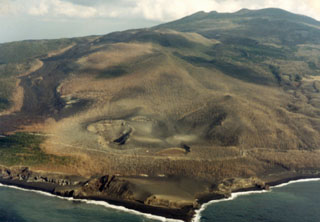Report on Miyakejima (Japan) — June 2009
Bulletin of the Global Volcanism Network, vol. 34, no. 6 (June 2009)
Managing Editor: Richard Wunderman.
Miyakejima (Japan) Four minor eruptions between August 2006 and April 2009
Please cite this report as:
Global Volcanism Program, 2009. Report on Miyakejima (Japan) (Wunderman, R., ed.). Bulletin of the Global Volcanism Network, 34:6. Smithsonian Institution. https://doi.org/10.5479/si.GVP.BGVN200906-284040
Miyakejima
Japan
34.094°N, 139.526°E; summit elev. 775 m
All times are local (unless otherwise noted)
Miyake-jima has had a recent history of periodic minor eruptions and gas emissions containing relatively high concentrations of sulfur dioxide (SO2). SO2 emissions in January 2006 averaged about 2,000-5,000 tons per day, and there was a minor eruption on 17 February 2006 (BGVN 31:03).
The Tokyo Volcanic Ash Advisory Center (VAAC) described an eruption on 23 August 2006 that generated plumes which rose to an altitude of about 1.5 km and drifted SE. Ash was not identified on satellite imagery. No additional eruption reports were received until January 2008. Based on information from the Japan Meteorological Agency (JMA), the Tokyo VAAC reported that an eruption plume on 7 January rose to an altitude of 1.2 km and drifted SE. The JMA also reported an eruption on 8 May 2008. Another eruption reported by JMA produced an ash plume that rose 600 m above the crater and drifted E on 1 April 2009.
Geological Summary. The circular, 8-km-wide island of Miyakejima forms a low-angle stratovolcano that rises about 1,100 m from the sea floor in the northern Izu Islands about 200 km SSW of Tokyo. The basaltic volcano is truncated by small summit calderas, one of which, 3.5 km wide, was formed during a major eruption about 2,500 years ago. Numerous craters and vents, including maars near the coast and radially oriented fissure vents, are present on the flanks. Frequent eruptions have been recorded since 1085 CE at vents ranging from the summit to below sea level, causing much damage on this small populated island. After a three-century-long hiatus ending in 1469 CE, activity has been dominated by flank fissure eruptions sometimes accompanied by minor summit eruptions. A 1.6-km-wide summit crater was slowly formed by subsidence during an eruption in 2000.
Information Contacts: Tokyo Volcanic Ash Advisory Center (VAAC), Tokyo, Japan (URL: http://ds.data.jma.go.jp/svd/vaac/data/); Japan Meteorological Agency (JMA), Otemachi, 1-3-4, Chiyoda-ku Tokyo 100-8122, Japan (URL: http://www.jma.go.jp/).

